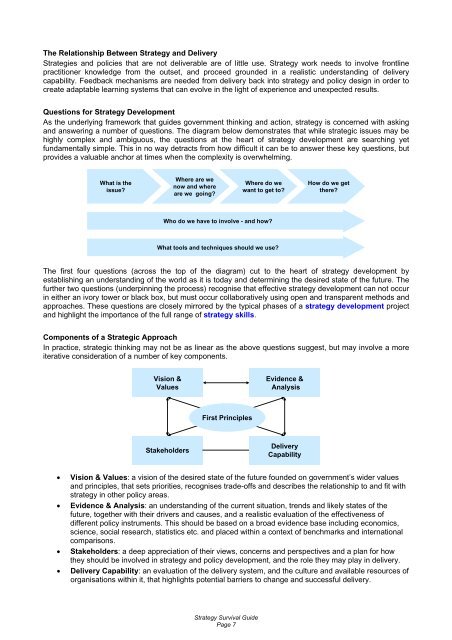Strategy Survival Guide
Strategy Survival Guide
Strategy Survival Guide
You also want an ePaper? Increase the reach of your titles
YUMPU automatically turns print PDFs into web optimized ePapers that Google loves.
The Relationship Between <strong>Strategy</strong> and Delivery<br />
Strategies and policies that are not deliverable are of little use. <strong>Strategy</strong> work needs to involve frontline<br />
practitioner knowledge from the outset, and proceed grounded in a realistic understanding of delivery<br />
capability. Feedback mechanisms are needed from delivery back into strategy and policy design in order to<br />
create adaptable learning systems that can evolve in the light of experience and unexpected results.<br />
Questions for <strong>Strategy</strong> Development<br />
As the underlying framework that guides government thinking and action, strategy is concerned with asking<br />
and answering a number of questions. The diagram below demonstrates that while strategic issues may be<br />
highly complex and ambiguous, the questions at the heart of strategy development are searching yet<br />
fundamentally simple. This in no way detracts from how difficult it can be to answer these key questions, but<br />
provides a valuable anchor at times when the complexity is overwhelming.<br />
What is the<br />
issue?<br />
Where are we<br />
now and where<br />
are we going?<br />
Where do we<br />
want to get to?<br />
How do we get<br />
there?<br />
Who do we have to involve - and how?<br />
What tools and techniques should we use?<br />
The first four questions (across the top of the diagram) cut to the heart of strategy development by<br />
establishing an understanding of the world as it is today and determining the desired state of the future. The<br />
further two questions (underpinning the process) recognise that effective strategy development can not occur<br />
in either an ivory tower or black box, but must occur collaboratively using open and transparent methods and<br />
approaches. These questions are closely mirrored by the typical phases of a strategy development project<br />
and highlight the importance of the full range of strategy skills.<br />
Components of a Strategic Approach<br />
In practice, strategic thinking may not be as linear as the above questions suggest, but may involve a more<br />
iterative consideration of a number of key components.<br />
Vision &<br />
Values<br />
Evidence &<br />
Analysis<br />
First Principles<br />
Stakeholders<br />
Delivery<br />
Capability<br />
• Vision & Values: a vision of the desired state of the future founded on government’s wider values<br />
and principles, that sets priorities, recognises trade-offs and describes the relationship to and fit with<br />
strategy in other policy areas.<br />
• Evidence & Analysis: an understanding of the current situation, trends and likely states of the<br />
future, together with their drivers and causes, and a realistic evaluation of the effectiveness of<br />
different policy instruments. This should be based on a broad evidence base including economics,<br />
science, social research, statistics etc. and placed within a context of benchmarks and international<br />
comparisons.<br />
• Stakeholders: a deep appreciation of their views, concerns and perspectives and a plan for how<br />
they should be involved in strategy and policy development, and the role they may play in delivery.<br />
• Delivery Capability: an evaluation of the delivery system, and the culture and available resources of<br />
organisations within it, that highlights potential barriers to change and successful delivery.<br />
<strong>Strategy</strong> <strong>Survival</strong> <strong>Guide</strong><br />
Page 7
















